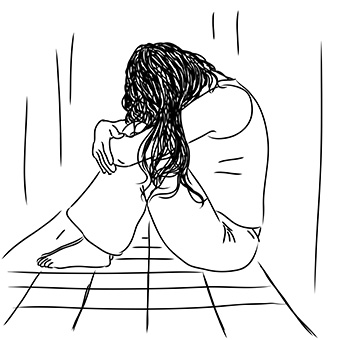3 Types of Mental Illness Stigmas and how Therapy can Help
What is a mental illness stigma? The word stigma refers to a trait that elicits social disapproval. Stigmas are often assigned to people with mental illness and can also affect people who break any kind of taboo (American Psychological Association).
Certain illnesses that have a negative perception, or stigma, attached to them, can make people feel especially isolated and excluded from the people who do not manifest that stigma. A stigmatized illness like schizophrenia, for example, is more likely to be met with judgment, distancing, and social isolation, than an illness such as cancer.
Here are three types of stigma and ways that they impact people who experience mental illness. We also explain key ideas for people who want to challenge stigmas and work toward a more understanding, compassionate world.
1. Public Stigma Occurs When People View a Trait or Disease as “Bad” or “Wrong”

Public stigmas manifest when groups of people believe that some traits are more desirable or “normal” than other traits. Because some stigmas are visible, such as having a visible disability, many people who have stigmas need to negotiate an ableist world that directly and indirectly challenges their worth. There are stigmas against people with mental health conditions, although that is slowly changing.
Erving Goffman conveys the social ramifications of stigma in his 1986 classic, Stigma: Notes on the Management of Spoiled Identity. Goffman’s sociological review of stigmas explores how public stigmas and stereotypes differ across cultures and throughout history.
Public stigmas can have harmful ramifications when they cause people to associate negative feelings and behaviors with an entire group of people, and then create policies to oppress that “othered” group. For example, if there is a public stigma for people struggling with drug addictions, and there is a stereotype of “drug addicts being bad or dangerous,” then city-wide officials who abide by those beliefs might be less likely to allocate funding for rehabilitation programs or transitional housing.
2. Self-stigma Can Happen When People with Stigmas Internalize Shame

There can be a harsh cycle of self-loathing for people who internalize the judgment they receive and in turn, blame themselves for their difference rather than question socially reinforced hierarchies.
You can recognize self-blame and shame when people make comments like, “I don’t deserve to get better” or “I am a burden to myself and society.” Rather than recognizing the complicated interplay of social and political spheres, people with self-stigmas are more likely to blame themselves.
Because of self-stigmas, people are more reluctant to ask for help, due to a myriad of reasons, including a possible belief that they don’t deserve different treatment from society.
3. Structural Stigmas Exist in the Policies that Marginalize People with Stigmas
Let’s focus on mental illness. Structural stigmas for mental illness can be seen when workplace policies discriminate against people for having a mental illness, but not against people for having a “body” illness. Both types of discrimination are not always legal, but they can happen in covert ways that are difficult to track.
Structural barriers can be embedded in healthcare policies, employment and income options, housing options, education systems, criminal justice policies, immigration policies, reproductive rights, and more. For example, many people with schizophrenia who are trying to secure a job or housing feel that they cannot disclose that information because they would “never be hired” on account of their illness–even if they manage their illness with therapy and psychiatry. People who have been incarcerated and have mental illness may face double discrimination for breaking two social taboos at once. Landing a job while having a stigmatized identity can be difficult.
Exploring Stigmas: Raising Awareness is the First Step
One way to expand your awareness of stigmas is to ask yourself any of the following questions. Note or record your thoughts and over time, as you learn more about public stigmas, self-stigmas, and structural stigmas, see how your answers adapt.
Questions that explore stigmas:
- What do I define as a ‘normal’ body?
- What counts as a ‘normal’ occupation for me?
- What do I consider a ‘normal’ living situation?
- What is a ‘normal’ problem to have or show in society?
- Where did I absorb my ideas of “normal?”
People are most likely to empathize with people we can relate to, so try to not blame or judge yourself for whatever biases arise. Instead, ask where they may come from, these subtle messages that some lives matter more than others.
For example, if you feel more empathy toward a woman who lives in a house and is a teacher who is having a bad day, than, say, a woman without a house who has schizophrenia and is also having a bad day, you may want to ask–from a place of curiosity, not blame–why that is. Stigmas often relate to a bigger personal and social question: how do we decide who gets empathy? The book Misery and Company by Candace Clark offers more insight around this complicated question and its real-life ramifications.
More Ways to Learn about Stigmas

Remember that stigmas change over time. For example, in the 1950s, people who went to therapy risked being stigmatized. Now, social norms have shifted so that among some cultures, it’s seen as an asset if you prioritize your mental health and have a therapist for added support.
Here are three additional ways you can take your knowledge of stigmas to the next level.
- Host a book club with Erving Goffman’s sociology book, Stigma: Notes on the Management of Spoiled Identity. Gather to discuss how your idea of stigmas has changed after reading this book, if applicable.
- Ask yourself if you have ever felt the impact of a public, self, or structural stigma. Write your personal story down and if you feel safe, share your story with a friend, colleague, therapist, or someone you know. One way of reducing the harm of stigmas is to talk openly about how stigmas have personally impacted our life; of course, this also puts the burden of change on the person already impacted by the stigma, which is not ideal.
- Call out stigmas when you see them, especially if the stigma does not directly target you. You can be a mental health ally when someone says a harmful comment at work, for example, that makes fun of people with mental illness. There are ways to handle this in a way that makes the person who made the comment feel open to learning, such as waiting for a private moment to pull them aside and tell them how the comment affected you.
Can Therapy Deepen My Awareness of Stigmas?
Therapy can help people assess the beliefs and values that inform how they live and how they value the people around them. Therapists and counselors can also help people gain tools for how to manage a stigmatized illness and have compassion for themselves, rather than internalized shame.
We encourage residents in Redding, Eureka, Fairfield, Woodland, Monterey, Salinas, Red Bluff and Hollister to request an appointment to work with a NAMHS therapist in person or inquire about our online therapy care.







